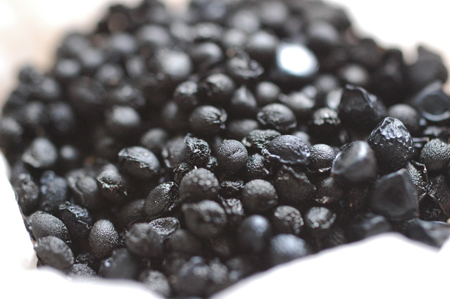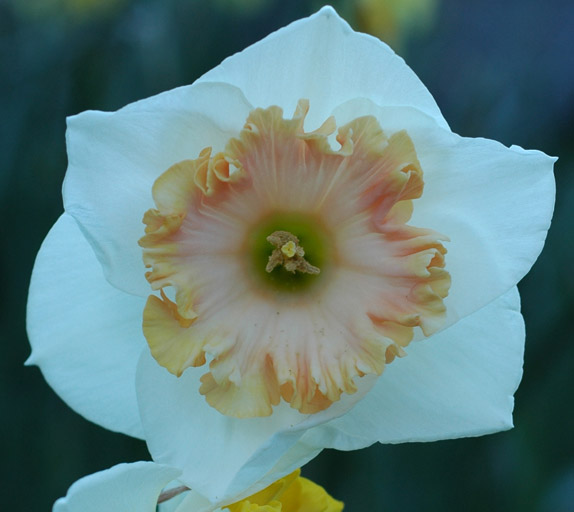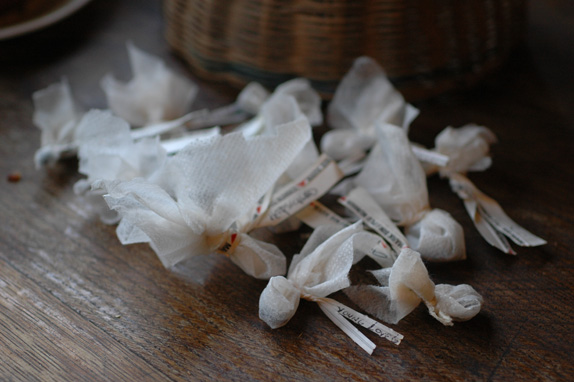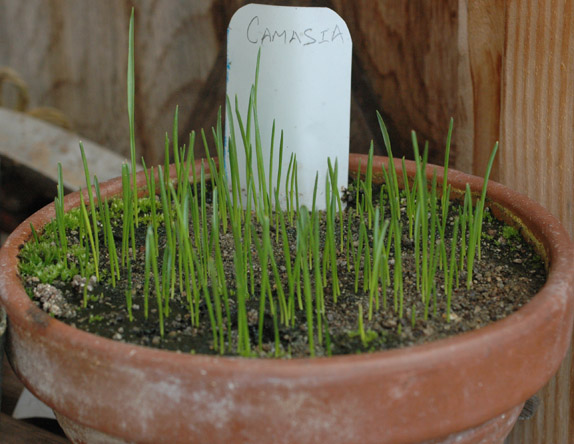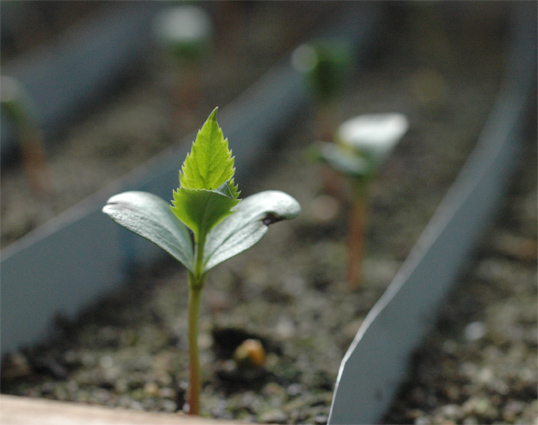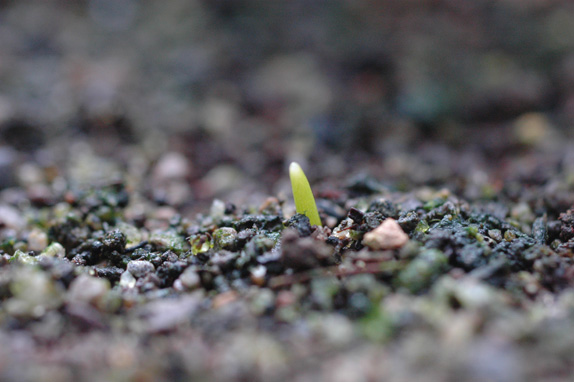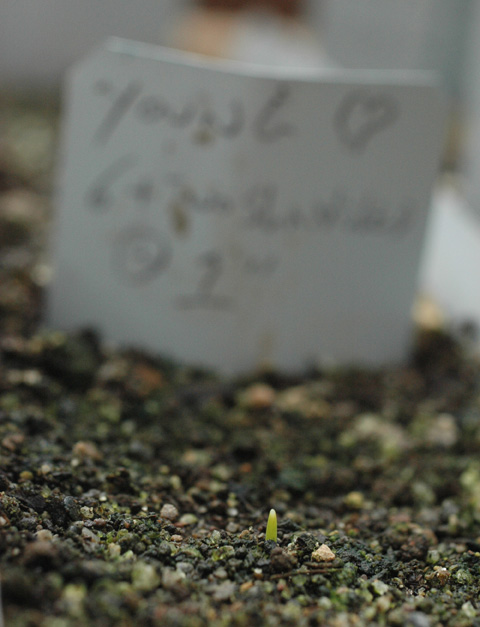 About half of the Daffodil seeds from my first year’s breeding experiments germinated and grew last winter, including 3 out of 8 Young Love seeds. The plants seemed healthy enough. They grew one narrow leaf each in a flat of soil mix in the greenhouse maturing little bean sized bulbs. The leaves turned yellow in late spring and then brown, wilting down for the summer sleep. By all accounts, Daffodils take a long time from seed to flower, so I have a wait ahead of me until they are ready to expose their pretty faces to the sun the wind the rain the bees and the bugs.
About half of the Daffodil seeds from my first year’s breeding experiments germinated and grew last winter, including 3 out of 8 Young Love seeds. The plants seemed healthy enough. They grew one narrow leaf each in a flat of soil mix in the greenhouse maturing little bean sized bulbs. The leaves turned yellow in late spring and then brown, wilting down for the summer sleep. By all accounts, Daffodils take a long time from seed to flower, so I have a wait ahead of me until they are ready to expose their pretty faces to the sun the wind the rain the bees and the bugs.
This past blooming season I pollinated yet more daffodil flowers and now have over 400 seeds to show for some minor and mostly enjoyable efforts. I used a lot of pollen from cultivars that I really like, but I was not as selective in regards to the seed parents. I figured there are two basic approaches to this and other plant breeding, careful and sloppy. I have little doubt that an approach using carefully selected stock, keeping precise records, using durable labels, researching the fitness or unfitness of the parents for breeding, and learning to select and breed for desirable genetic traits could greatly increase my chances of ending up with really great offspring. That approach however, sounds about as fun as waiting in line at a bank. I’m sure it’s loads of fun for someone, but I’m not a person that enjoys record keeping overly much. Record keeping and the like are tools that I use to the extent that they are needed, or probably somewhat less than the extent to which they are needed; appreciate it I do, but enjoy it I do not. The other basic approach, and the one I’m currently favoring, is that of sloppy promiscuity and minimal attention to planning, details and after care. You can’t eat daffodils, and I have lots of other projects requiring study time and mental energy, so I’m liking the casual approach for my daffodil breeding. (Edit: This article about daffodil breeder Ron Scamp says that flower form comes from the seed parent and color from the pollen parent. It also says that perianth (petal) colors are hard to cross, but corona colors (the trumpet) are easier to cross. I don't think that's too much information to kill my buzz, so I'll be experimenting accordingly:)
Daffodils are easy enough to pollinate in general. Some of them are sterile or produce very little or no pollen, but from my experiments so far, most of them appear to be fertile. It takes very little time to run around dabbing some pollen here and there, so I don’t worry about who is or isn’t fertile or sterile, or just plain not in the mood. I didn’t even mark the pollinated flowers, but simply went back in early summer to look for fat seed pods. It seems as though Daffodils are almost never pollinated naturally in this environment, so any seeds that form are almost certainly the results of intentional crosses. A few of the flowers pollinated formed no seed. Whether the failures were due to sterile pollen, sterile stigmas or poor timing I don’t know. I had no success at all with the small narcissus types like Minor Monarch, Grand Primo, Golden Dawn and Chinese Sacred Lily, but most others produced at least a seed or two. I probably spent less than two hours to pollinate and then collect those hundreds of seeds this year. Even if my germination rate doesn’t improve over 50% I’m happy enough with those numbers. I do think that I could get more seeds per pod by pollinating the same flower several days in a row, but I’m not going to lose any sleep over it.
Daffodils are generally easy to grow. Under our environmental conditions, I imagine that I could probably take my little bean sized bulbs, put them into barely better than field conditions this fall and expect most of them to survive with only minor intervention. They might not grow to flowering size nearly as quickly as they would with some pampering, but the point is that they will take no extraordinary care to survive and come to flowering age. The bulbs will probably get a small space in the garden for at least a year to increase the bulb size and therefore the probability of survival in the field. The ease with which Daffodils are pollinated and grown, coupled with the fact that I’m breeding for fun rather than for profit or fame, form the foundation of my new low input Daffodil breeding program. So what if I don’t know who the parents of my illegitimate Daffodils are? So what if they take longer to flower because I don’t pamper them? So what if I have fewer awesome flowers and more ugly ducklings? This is about investment and return, not just how much investment and how much return, but about what kind of investment for what kind of return. Instead of fussing with records and tags which may take as much or more time than the breeding and growing, I’m opting to produce more offspring with less and more enjoyable effort. After all, we reap the experience of our labor as well as the fruits. More life, less paper!
I’m hoping that it will take me only a few hours a year to come up with a couple hundred seedlings and a little more time to get them growing somewhere the following year. I’m hoping for 4 to 6 hours a year for 200 or more seedlings each of which holds the promise of unique genetics. I’m thinking of dedicating an area in one of the orchards to be a treasure chest of daffodil seedlings. If I plant more every year, I could have as many as a couple hundred new flowers to check out each season. Once they start blooming, I reap the pleasure and adventure of seeing more of those seedlings come into flower every year resplendent in all their ravishing beauty, mutated weirdness or stunning mediocrity. And even if most are plain or unsightly, it seems like there must remain a pretty decent chance that if I add more every year I could just end up with a flower worthy of the attention of someone besides me. I doubt I’ll be collecting any Daffodil breeding awards, but I’m sure my flowers will make someone pause or smile. I also get to name them which has to be half the fun at least! OMG, I can't wait. I think I'll start a list now. Maybe I’ll change my mind and eventually approach the process with more care. I’ll admit that a few pieces of information about the dominance of genetic traits could prove useful, but I can pick that up anytime along the way and for now the unmethodical approach looks pretty good and more importantly, feels fun instead of stressful.
So the Daffodil breeding blogging saga comes to a pause. Hopefully in a few years I’ll be posting pictures of my motley collection of bastard daffodil seedlings. In the meantime, I don’t feel particularly impatient since my investment has become minimal. I hope the rest of you can stand the suspense though. RELATED POSTS:


